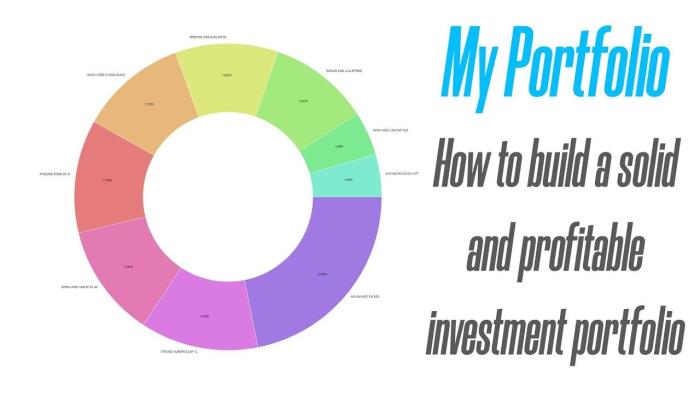How to build an investment portfolio is a crucial aspect of financial planning, allowing individuals to grow their wealth and achieve their goals through strategic investment choices. In this guide, we will delve into the key elements and strategies involved in creating a successful investment portfolio.
Introduction to Investment Portfolio Building

Investing in a well-structured portfolio is essential for individuals looking to grow their wealth and achieve their financial goals. An investment portfolio consists of a collection of assets such as stocks, bonds, real estate, and other investment vehicles. The significance of building a diverse portfolio lies in the ability to spread risk and maximize returns over time.
Key Elements of a Well-Diversified Portfolio
A well-diversified portfolio typically includes a mix of asset classes, industries, and geographical regions. By spreading investments across different categories, investors can reduce the impact of market volatility on their overall portfolio performance. Diversification helps mitigate risk and ensures that a single market event does not have a significant negative impact on the entire investment portfolio.
- Asset Allocation: Allocating investments across various asset classes such as equities, fixed income, and alternative investments is crucial for achieving a balanced portfolio.
- Industry Exposure: Investing in companies from different industries helps spread risk and ensures that the portfolio is not too heavily concentrated in one sector.
- Geographical Spread: Including investments from different regions or countries can provide exposure to varying economic conditions and reduce the impact of geopolitical events on the portfolio.
“Diversification is the only free lunch in investing.” – Modern Portfolio Theory
Importance of Goal Setting
Before embarking on the journey of building an investment portfolio, it is essential to establish clear financial goals. Setting specific, measurable, achievable, relevant, and time-bound (SMART) goals can help investors determine the appropriate investment strategy to achieve their objectives. Whether the goal is to save for retirement, purchase a home, or fund a child’s education, having a clear roadmap can guide the investment decisions and asset allocation within the portfolio.
Types of Investments to Include
Investing in a variety of assets is crucial for building a diversified investment portfolio. Here are some types of investments to consider:
Stocks
Investing in stocks involves purchasing shares of ownership in a publicly traded company. Stocks are known for their potential high returns, but they also come with high volatility and risk. It’s important to research and select individual stocks or invest in diversified mutual funds or exchange-traded funds (ETFs) to reduce risk.
Bonds
Bonds are debt securities issued by governments, municipalities, or corporations. They are considered less risky than stocks and provide a fixed income stream through interest payments. Bonds offer more stability to a portfolio and are often used to balance out the riskier assets like stocks.
Real Estate
Investing in real estate can provide both income and capital appreciation. This can be done through direct ownership of properties, real estate investment trusts (REITs), or real estate crowdfunding platforms. Real estate investments can offer diversification and a hedge against inflation.
Commodities
Commodities such as gold, silver, oil, and agricultural products can serve as a hedge against inflation and economic uncertainty. Investing in commodities can add diversification to a portfolio and provide protection during times of market volatility.
Alternative Investments, How to build an investment portfolio
Alternative investments include assets like hedge funds, private equity, venture capital, and cryptocurrency. These investments typically have higher risk and less liquidity compared to traditional assets. Including a small allocation of alternative investments can enhance portfolio diversification and potentially boost returns.
Cash Equivalents
Cash equivalents like money market funds, certificates of deposit (CDs), and short-term Treasury bills provide stability and liquidity to a portfolio. While they offer lower returns compared to other investments, cash equivalents serve as a safe haven during market downturns.
Setting Investment Goals
Setting investment goals is a crucial step in building a successful investment portfolio. These goals help investors define their objectives, risk tolerance, and time horizon, guiding them in making informed investment decisions.
Short-term and Long-term Investment Goals
Setting short-term investment goals typically involves targets that can be achieved within a year or two. These goals may include saving for a vacation, purchasing a new car, or building an emergency fund. On the other hand, long-term investment goals are focused on objectives that require more time to achieve, such as retirement planning, buying a home, or funding a child’s education.
- Short-term goals: Saving $5,000 for a vacation in 12 months.
- Long-term goals: Accumulating $1 million for retirement in 25 years.
Risk Tolerance and Time Horizon Influence
Risk tolerance refers to an investor’s willingness to endure volatility or potential losses in their investment portfolio. It plays a significant role in determining the type of investments suitable for an individual. Time horizon, on the other hand, refers to the length of time an investor plans to hold their investments before needing to access the funds.
- Investors with a high-risk tolerance may set more aggressive investment goals to pursue higher returns.
- Investors with a longer time horizon may be more inclined to take on higher risk for potentially higher rewards.
SMART Investment Goals
When setting investment goals, it is essential to follow the SMART criteria to ensure they are Specific, Measurable, Achievable, Relevant, and Time-bound.
- Specific: Saving $10,000 for a down payment on a house in three years.
- Measurable: Tracking progress towards the goal using monthly savings contributions.
- Achievable: Setting realistic targets that align with income and expenses.
- Relevant: Choosing goals that are meaningful and align with long-term financial objectives.
- Time-bound: Establishing a deadline for achieving the goal, such as three years for the down payment target.
Diversification Strategies: How To Build An Investment Portfolio

Diversification is a crucial strategy in building an investment portfolio as it helps reduce risk by spreading investments across different asset classes. By diversifying, investors can protect their portfolio from being too heavily impacted by the performance of a single investment.
Asset Allocation
When allocating assets across different investment classes, it is important to consider your risk tolerance, investment goals, and time horizon. A common approach is to invest in a mix of stocks, bonds, and cash equivalents to create a well-balanced portfolio. Each asset class carries its own level of risk and return potential, so spreading investments among them can help manage overall portfolio risk.
- Stocks: Equities offer growth potential but come with higher volatility. They are suitable for long-term investors seeking capital appreciation.
- Bonds: Fixed-income securities provide regular income and stability. They are less volatile than stocks and can help reduce overall portfolio risk.
- Cash Equivalents: These include money market funds and short-term CDs, offering liquidity and stability. They are low-risk investments ideal for preserving capital.
Portfolio Rebalancing
To maintain diversification in your portfolio, it is essential to periodically rebalance your investments. Rebalancing involves adjusting the allocation of assets back to your target mix to ensure that your portfolio remains aligned with your investment goals.
Rebalancing allows investors to buy low and sell high, selling assets that have performed well and buying more of those that have underperformed to maintain the desired asset allocation.
Risk Management Techniques
When building an investment portfolio, it is crucial to consider risk management techniques to protect your investments from potential downturns. By implementing effective risk management strategies, investors can safeguard their portfolio against unforeseen market fluctuations and minimize losses.
Asset Allocation for Risk Management
Asset allocation plays a significant role in managing risk within an investment portfolio. By diversifying investments across various asset classes such as stocks, bonds, real estate, and commodities, investors can reduce their exposure to the volatility of any single asset class. This diversification helps in spreading risk and protecting the portfolio from significant losses during market downturns.
Hedging to Protect the Portfolio
Hedging is a risk management strategy used to protect a portfolio from adverse market movements. Investors can hedge their investments by using derivatives such as options, futures, or swaps to offset potential losses. By taking offsetting positions, investors can mitigate the impact of market volatility and safeguard their portfolio from significant downside risk.
Monitoring and Adjusting the Portfolio
Monitoring and adjusting an investment portfolio is crucial to ensure that it remains aligned with your financial goals and risk tolerance. Regular reviews help to identify underperforming assets, rebalance the portfolio, and make necessary adjustments based on changing market conditions.
Frequency of Portfolio Review
- Investment portfolios should be reviewed at least once a quarter to assess performance and make any necessary changes.
- However, in times of market volatility or significant life events, more frequent reviews may be warranted.
Importance of Monitoring and Adjusting
- Monitoring investment performance allows you to capitalize on opportunities and mitigate risks in a timely manner.
- Adjusting the portfolio ensures that it remains diversified and aligned with your investment objectives.
- Regular reviews also help to prevent emotional decision-making and maintain a disciplined approach to investing.
Making Changes to the Portfolio
- Changes to the portfolio should be based on a combination of market conditions, your financial goals, and risk tolerance.
- Rebalancing the portfolio involves selling overperforming assets and buying underperforming ones to maintain the desired asset allocation.
- Consider consulting with a financial advisor before making significant changes to ensure they align with your long-term investment strategy.
In conclusion, mastering the art of building an investment portfolio requires a blend of knowledge, strategy, and ongoing monitoring. By implementing the right techniques and staying informed about market trends, you can work towards realizing your financial aspirations and securing a stable future.
You also can investigate more thoroughly about How to start investing to enhance your awareness in the field of How to start investing.


